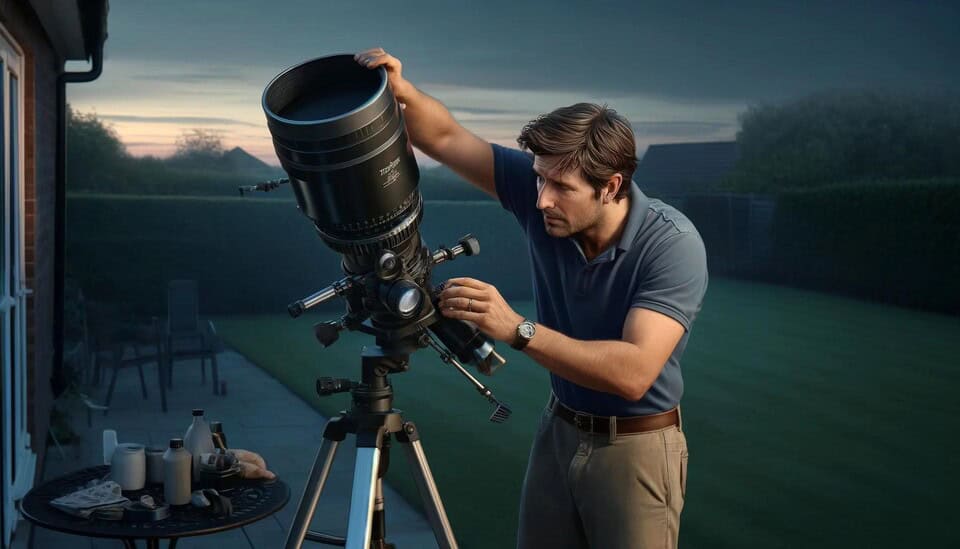A Barlow lens is a convenient tool that allows astronomers to typically double the magnification of their telescope as simple as changing an eyepiece. however, helpful as they are for bringing celestial objects closer into view, Barlow lenses are not free of setbacks.
A Barlow lens can narrow your field of view and potentially dim your view, especially on higher magnifications. It can add weight, affecting the balance of a telescope, and can complicate focusing, especially for beginners. A Barlow with improved optics and construction helps negate some issues.
Barlow’s essentially insert another optical element into the light path, which can lead to potential quality issues if not manufactured to high standards.
Magnification vs. Field of View: Finding the Balance
An increase in magnification also comes with a decrease in the field of view, making it more challenging to locate and track objects in the night sky. It’s crucial to consider whether the narrower field of view and potential challenges in tracking are worth the extra power. They may also introduce additional weight and complexity to an otherwise straightforward setup.
Additionally, while a Barlow lens can effectively increase the range of magnifications available, it can also exacerbate any existing defects in the eyepieces. Higher magnification can make issues like chromatic aberration and spherical aberration more noticeable, impacting the viewing experience. It’s important for users to weigh these potential downsides against the benefits of having expanded magnification options.
Understanding the Barlow Lens
The Barlow lens, an optical innovation in telescopes, magnifies the image and alters the focal length. Its integration affects the telescope’s weight distribution and may require additional cooling time, or temperature normalization for optimal performance.
Here is an article that may help as well. What A Barlow Lens Is & Does For Your Telescope
Design and Function
A Barlow lens multiplies the effective focal length of a telescope’s objective lens, resulting in increased magnification. It consists of a concave lens or a series of lenses designed to diverge light before it reaches the eyepiece. This lens is typically inserted between the telescope’s objective lens and the eyepiece.
- Design Characteristics:
- Concave lens setup
- Acts as a magnification multiplier
- Positioned between the objective lens and eyepiece
- Functional Impacts:
- Increases telescope’s effective focal length
- Enhances image magnification without sacrificing eye relief
- Additional Weight and Balance Issues: Introducing a Barlow lens to a telescope can affect its weight distribution. Users may need to adjust the telescope mount or add counterweights to maintain balance.
- Cooling Time: An extended focal length can also increase the telescope’s cooling time, which is important for reducing air currents that can blur the image.

Common Uses in Astronomy
Astronomers frequently use Barlow lenses to observe celestial objects that benefit from higher magnification, such as the moon, planets, and double or binary stars.
- Astronomical Targets Suited for Barlow Lenses:
- The Moon: Reveals crater details
- Planets: Enhances features like Jupiter’s cloud bands or Saturn’s rings
- Double Stars: Allows separation of closely positioned stars
By employing a Barlow lens, astronomers can efficiently switch between high and low magnification views without needing multiple eyepieces, adding versatility to their observations.
Optical Considerations
When adding a Barlow lens to a telescope’s optical system, one must consider how it affects the field of view, image brightness, and chromatic aberration. These factors can influence the effectiveness of the Barlow lens in enhancing the magnification of celestial objects.
Impact on Field of View
A Barlow lens typically reduces the field of view of the telescope. This is because it effectively increases the focal length, which narrows the scope of vision. Specifically:
- Reduced Field of View: A 2x Barlow lens would halve the field of view, making the observed patch of sky smaller.
Influence on Image Brightness
The introduction of a Barlow lens into a telescope’s optical path has implications for view brightness:
- Diminished View Quality: A Barlow lens increases magnification, focusing light into a smaller, more zoomed-in area. This can make views appear darker as the light from the object is spread thinner, reducing brightness especially at higher magnifications.
Chromatic Aberration Effects
The impact of a Barlow lens on chromatic aberration varies depending on the lens quality:
- Chromatic Aberration: A Barlow lens can introduce or exacerbate chromatic aberration, resulting in color fringing around objects. Higher quality apochromatic Barlow lenses can mitigate this effect to some extent.
Practical Challenges
While Barlow lenses are valuable tools for enhancing the magnification of telescopes, they introduce certain practical challenges that observers should consider before integrating them into their setup.
Handling and Portability
Barlow lenses add extra weight and length to the configuration of a telescope, which can make the equipment less convenient to balance on the mount. Astronomers must account for the possible focusing issues as well. Putting the barlow lens before the diagonal sometimes helps this focus problem. Knowing your focus travel limits will help you understand if a barlow will help you.
Setup and Operation Complexity
Integrating a Barlow lens into a telescope setup increases complexity in use. It requires additional steps in the assembly process, potentially extending setup time. This added complexity can be daunting for beginners who are not yet familiar with the delicate balance of telescope components.
All this is usually due to focusing as well. Make sure you get a correct size for your telescope, 2″ or 1-1/4″ are standard. Go with the biggest size you can if your telescope will allow it.
Compatibility With Other Equipment
Compatibility issues may arise when trying to use a Barlow lens with certain telescopes or eyepieces. It’s essential to ensure that the Barlow lens’s barrel size matches the eyepiece holder’s diameter, typically 1.25 inches or 2 inches, and that it’s fully compatible with the specific telescope model in use. Compatibility with diagonal mirrors or prisms should also be taken into account, as not all setups allow for the added length of a Barlow lens.
What Barlow’s would I buy? Well I tell you about 10 of them in this article for 2″ and 1-1/4″ sizes. Click here to access the 10 Barlow’s I like
Alternatives and Solutions
When using a Barlow lens, it is important to consider the optical changes it introduces to the telescope system, including potential issues with additional weight and balance. Here are some strategies to address these challenges:
Choosing the Right Barlow Lens
Selecting an appropriate Barlow lens for one’s telescope setup hinges on understanding the lens’s specifications and the intended observational goals. Magnification power and lens quality directly influence the visual outcome. For those concerned with weight:
- Choose a quality Barlow lens made from good materials.
- Consider the overall length and weight capacity on your mount. Rebalance with the Barlow lens, or find the happy medium with and without the Barlow installed.
Adapting to Barlow Lens Limitations
Barlow lenses can introduce balance issues due to the added weight at the eyepiece end. Here’s how astronomers manage:
- Use counterweights to maintain balance and prevent strain on the telescope mount.
- Adjust the mounting position, if possible, to better distribute the weight.
Maximizing Performance
To ensure optimal performance when employing a Barlow lens:
- Regularly clean the lens to avoid dust and fingerprints from degrading image quality. Or, better yet, store in a dust free environment with caps and enclosed container or bag.
- Pair the Barlow with high-quality eyepieces to mitigate any optical flaws that could arise from magnification.
Conclusion

While a Barlow lens offers increased magnification for telescopic observations, its use comes with several considerations one must account for. When employing a Barlow lens, diminished light throughput is noticeable, as the additional glass elements can slightly reduce the brightness of the image.
Users should also be aware of the potential for chromatic aberration, particularly with lower-quality Barlow lenses. This can introduce color fringing around objects, which may affect the clarity of the observed image.
Increased focal length also translates to a narrower field of view, meaning that it can be more challenging to locate and track celestial objects, especially those moving rapidly across the sky.
The quality of the Barlow lens is paramount. In instances where a high-grade lens is not used, the observer may experience degradation of view quality, with the potential for additional optical aberrations.
Moreover, a Barlow lens adds balance, focus and complexity issues to the optical setup, which may require additional balancing or focus issues and can lead to increased setup time.
Lastly, while Barlow lenses provide a cost-effective method of increasing magnification, they are not a replacement for a diverse eyepiece collection.
In conclusion, Barlow lenses are valuable tools for amateur and professional astronomers alike, but their benefits must be weighed against these drawbacks, depending on the observer’s specific needs and equipment capabilities and objects of viewing.
Frequently Asked Questions
Barlow lenses are valuable tools for increasing magnification in telescopic observations, but they bring along certain drawbacks that may affect the user experience and quality of astronomical imaging.
What are some potential negative effects of using a Barlow lens on image clarity?
A Barlow lens can introduce optical aberrations and decrease image clarity, especially if the lens quality is suboptimal. It may also exacerbate any existing issues with the telescope’s optics.
Can a Barlow lens alter the light input or brightness of my view?
Use of a Barlow lens results in a reduction of the light gathering capability of the setup, which may lead to a dimmer image, as it effectively increases the f-ratio of the telescope.
How does a Barlow lens impact the field of view during observations?
A Barlow lens typically narrows the field of view because the magnification of the image also magnifies the central area of observation, which can make it challenging to observe larger celestial objects. like zooming in on a picture.
Could I face any issues with chromatic aberration when using a Barlow lens?
Poor quality Barlow lenses can introduce chromatic aberration, leading to color fringing around bright objects, which is particularly noticeable when using high magnifications. Learn more about telescope lens coatings and which may be better for you.
Why might a Barlow lens not be recommended for certain types of telescopes or observations?
A Barlow lens may not be suited for wide-field observations as it reduces the field of view. Moreover, it’s less beneficial for telescopes that already have long focal lengths, as the increased magnification may exceed the practical limit for good image quality. This article may help understand Magnification and when it gets blurry
Are there any specific maintenance or handling challenges associated with Barlow lenses?
Handling and maintaining a Barlow lens requires care to avoid dust, fingerprints, and scratches, which can all degrade the quality of the view or image for astrophotography. They also add weight and possible focus issues. which creates a potential necessity for rebalancing or extension tubes.


